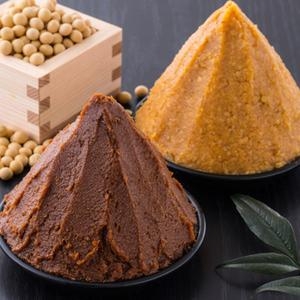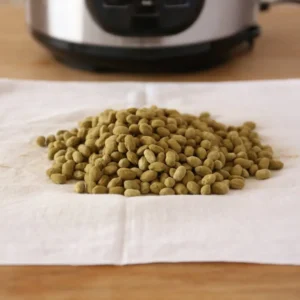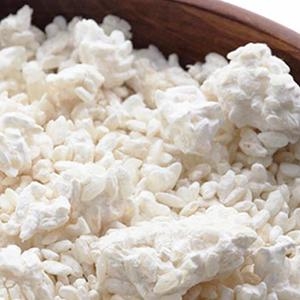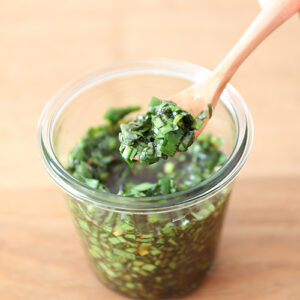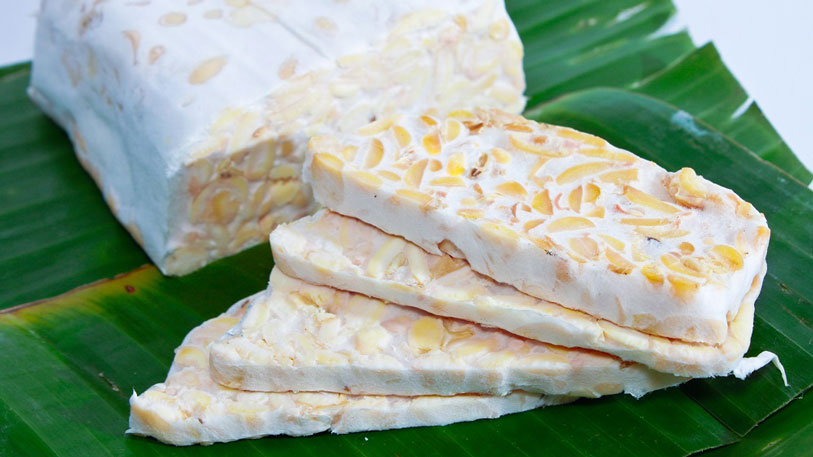
Have you ever heard about tempeh?
Here in Japan, it is hard to know people who actually have eat tempeh in their life. Some of them even don’t know about tempeh. But, there are actually people who are curious about tempeh and they would like to try it someday.
In this article, we will tell you all about tempeh, and why is it really important for your health. Once you know about tempeh and its benefits, please try to consume it by all means!
What is Tempeh, The Another Form of Fermented Soybeans
Tempeh is a fermented soybean product that native to Central Java Province, Indonesia
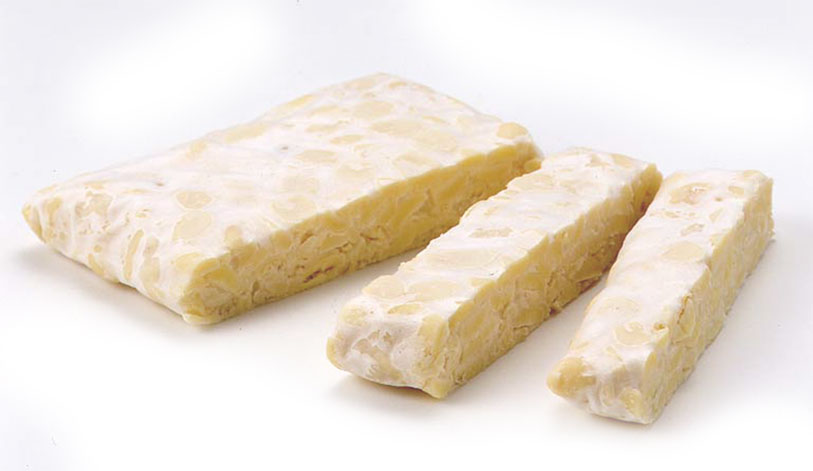
Like tofu, tempeh is made from soybeans. But tempeh is made by using the whole soybeans, so it has the complete or even greater nutrients from the soybean.
The nutrients contained are proteins, minerals, vitamin B, glucoses (energy), etc. Sometimes it is said that the amount of protein contained in soybeans is almost balanced with meat. Therefore, you can complete your daily nutrients intake by consuming tempeh.
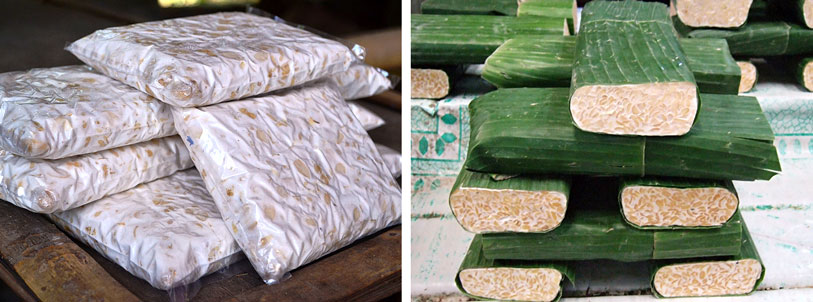
(Left picture: tempeh wrapped with plastic; right picture: tempeh wrapped with banana leaf)
The common tempeh we all know uses plastic for its container. But some tempeh in Indonesia uses banana leaves to wrap the tempeh. Banana leaf makes more tasteful tempeh because the leaves transfer a great aroma to the tempeh, with a note that the leaves used must be clean and fresh.
Nevertheless, plastic-wrapped tempeh is still delicious and more hygienic for most people. Plastic is also easy to find and cheaper compared to banana leaves. So it is also recommended to wrap it using plastic wrap such as zip lock, etc.
Because of its delicious taste and abundant nutrients, now tempeh is known worldwide. Tempeh contains lots of protein from plants, so tempeh is also loved by the vegan.
In fact, vegans worldwide are already using tempeh as the meat’s replacement. This protein-rich, easy to cook, and delicious tempeh will surely make your daily consumption more healthy and colorful!
How to Determine Good Quality of Tempeh?
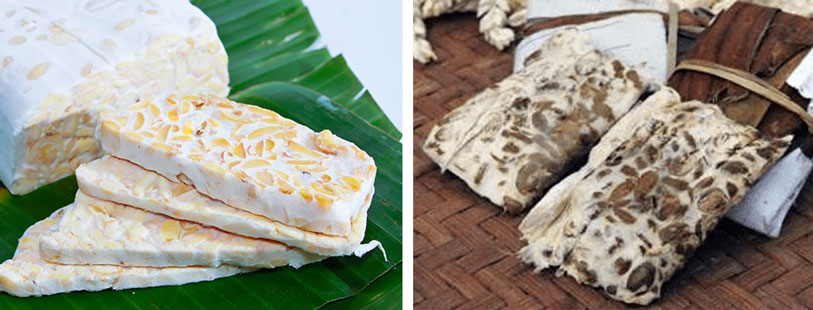
(Left picture: good tempeh; right picture: inedible tempeh)
Tempeh is made by the controlled fermentation process of the whole cooked soybean or other beans that undergo inoculation with Rhizopus spp. for further known as a ‘tempeh starter.’
Normally, tempeh can be deliciously consumed after 48 hours of the fermentation process. The ideal temperature for tempeh fermentation is around 29-32°C (room temperature in the warm country). We’d recommend you use a fermentation device to make tempeh during the cold season (Fall or Winter). If the white mycelium hasn’t covered most of the beans yet, please incubate the tempeh longer. You can extend the fermentation time until a maximum of 8 hours past the recommended time.
Learn more about how to make tempeh in our detailed How to Make Tempeh article here:
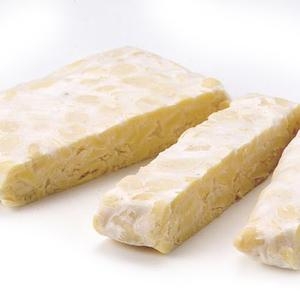
After the fermentation process, a mat of white mycelium knits together the beans, making the good-quality tempeh has a white color with a firm texture and nutty flavor. It is said that good tempeh has more white mycelium covering the soybeans. Therefore the beans should be barely visible. The odor is pleasant and resembles with mushroom’s aroma.
Tempeh becomes inedible when it is wet, slimy, and mushy with a collapsed structure. Inedible tempeh has a strong odor that resembles the odor of strong ammonia or alcohol.
One of the reasons tempeh becomes inedible is the continuation of the fermentation process. Extended fermentation time increases pH, making undesirable color darkening in tempeh and inedible. Therefore, it is better to cook it immediately after the fermentation process is finished.
How to Store Tempeh?
One thing to note is tempeh generally have short storage period. Please store the freshly fermented tempeh in the refrigerator for 48 hours. The fridge stops the fermentation process and prevents the tempeh from decaying at a certain time. If you continue to store it at room temperature, you must cook it maximumly in the next 24 hours. You can either fry it or mix it with other dishes.

Tempeh is treasured and loved by Indonesian people. Not only have a long history in Indonesia, tempeh is also good for your health. Indonesia have lots of traditional recipe to deliciously enjoy tempeh, and we would like to share some of it in this article.
To jump to the recipe’s section, please click here.
Is Tempeh Good for Your Health?
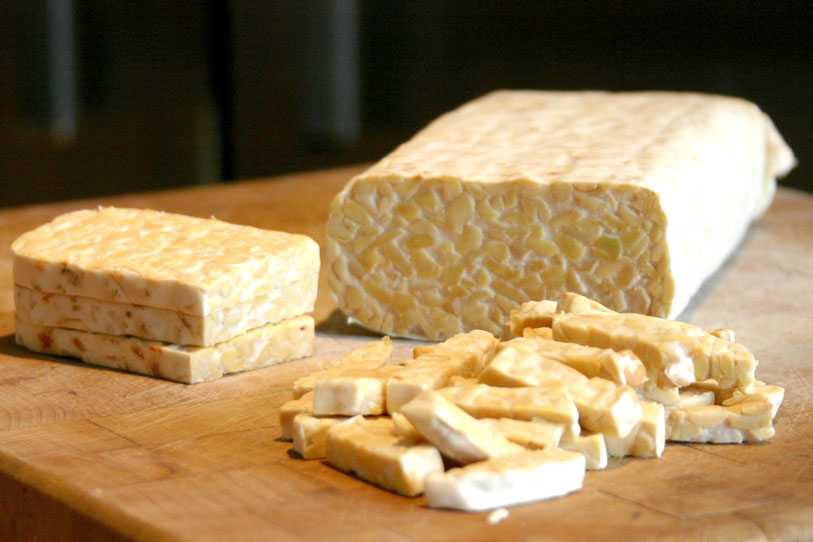
Yes! Tempeh is known as a food full of nutrients. There are lots of study saying that tempeh contains lots of nutrients, so it’s good to consume tempeh daily for your health. Some studies also show that tempeh nutrients are more easily digested, absorbed, and utilized by the body compared to those in soybeans due to the fermentation process.
One serving of tempeh (100 grams) provides around 200 calories, around 20 grams of protein, around 10 grams of carbohydrates, around 60 grams of water, and more other good substances for your body such as plant fiber, Vitamin B, antioxidant, etc. Tempeh is said to be one of the low-calorie food with a high-fiber, so it is also good to consume tempeh for diet.
Here’s some health benefits from tempeh:
Health Benefit 1 Cancer Prevention & Anti-Aging Benefits

A study showed that Asian countries have among the lowest rates of common cancers in Western society, such as breast cancer, prostate cancer, and colon cancer.
This is one of the diet benefits when consuming soy. Soybean contains isoflavone and antioxidant that was called for cancer-prevention ingredients. It is also effective for anti-aging effects.
Health Benefit 2 Cardiovascular Benefits

Even though few studies of tempeh and cardiovascular effect, we are familiar that whole soy food products provide better cardiovascular support. This includes tempeh.
The antioxidant and anti-inflammatory properties of soy peptides found in tempeh can help protect the blood vessels from oxidative and inflammatory damage. Tempeh also acts as a hypocholesterolemic that is a cholesterol-lowering effect. The most consistent effect of soybean intake on blood fats has been a moderate lowering of LDL (Low-Density Lipoprotein) cholesterol (the “bad” cholesterol). Some studies show other positive impacts on blood fats, like the lowering of triglycerides and total cholesterol.
Health Benefit 3 Rich in Vitamin B Complex

Vitamin B complex is usually found in milk, meat, egg, and fish. But, tempeh is also rich in Vitamin B Complex. One of them is Vitamin B12 that is good for helping the growth of red blood cells.
Therefore, people who consume tempeh can lower the risk of anemia and its symptoms, such as dizziness and fatigue.
Health Benefit 4 Help You Lose Weight

Tempeh is a delicious protein menu for everyone of all ages. If you are on a diet and consuming soy daily, it can help you lose weight because it is rich in plant fiber. The fiber can bind some energy and fat and be disposed of it together with the feces. So there will be no accumulation of fat in the body which can cause obesity.
If you are already consuming tempeh, then you are a lucky person. Tempeh is said to be a good ingredient to prevent many diseases. You can start to improve your healthy lifestyle by consuming tempeh as a daily intake.
Health Benefit 1Cancer Prevention & Anti-Aging Benefits

A study showed that Asian countries have among the lowest rates of common cancers in Western society, such as breast cancer, prostate cancer, and colon cancer.
This is one of the diet benefits when consuming soy. Soybean contains isoflavone and antioxidant that was called for cancer-prevention ingredients. It is also effective for anti-aging effects.
Can You Eat Raw Tempeh?
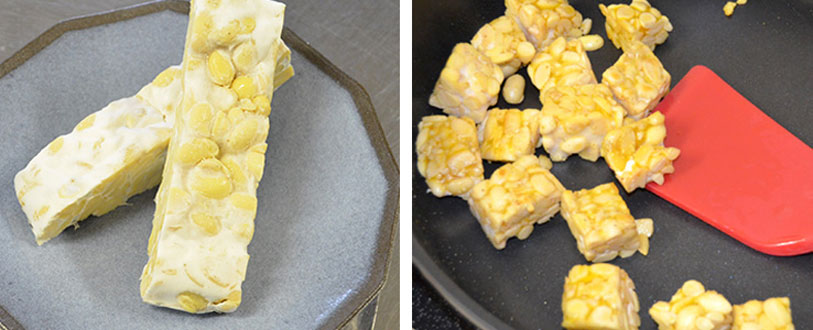
You can eat both raw or cooked tempeh.
For most people, tempeh is more delicious if you cook it rather than eat it raw. It is because raw tempeh smells like mushroom and doesn’t have any flavor. Even so, raw tempeh doesn’t cause any damage to your body, so you also can eat it raw.
Cooked tempeh will have delicious flavor and texture, depending on how you cook it. It’s delicious to enjoy tempeh cooked by deep-frying, boiling, or stir-frying it. But, again, it is easy to cook and does have many recipes so you won’t get bored with one dish.
Be adventurous to try lots of tempeh recipes and find your favorite tempeh dish!
Where to Buy Tempeh?
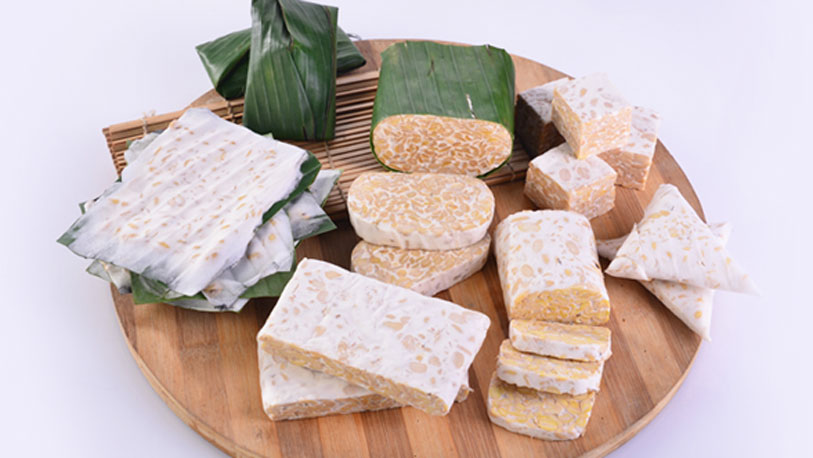
Buying tempeh outside Indonesia won’t be that easy. Sometimes, finished tempeh is available at the Asian supermarkets, or grocery stores worldwide but still the number are still small so it is hard to find.
So how we can try to eat tempeh?
Well, why don’t you try to make homemade tempeh?
Homemade tempeh is good because you can use your favorite and high-quality ingredients of your own choice. In that case, homemade tempeh is sometimes healthier than commercial tempeh. In addition, making homemade tempeh is not difficult.
You will need a tempeh starter, soybeans (we are using organic soybeans), and plastic (ziplock) for wrapping the tempeh. Find the ingredients to make homemade tempeh on our website!
The all-in-one, Homemade Tempeh Kit is also available for a more affordable price!
Recommended Recipes for Tempeh
Tempeh is most delicious when it is fried or when added to other dishes. In Indonesia, tempeh has become one of their everyday food. At least Indonesian people eat tempeh once a week.
Although there are many tasty recipes using tempeh, we will introduce you to two of our favorite ones.
One is fried, and another is boiled, then fried (optional). The first recipe has a savory taste, and another one is the mixed taste between savory and sweet.
These recipes are original recipes from Indonesia and are still used as their treasured local food. Kawashima The Japanstore summarized the recommended recipes from Indonesian people who eat tempeh in daily consumption. Without further ado, let’s get to the recipe!

Tempeh Mendoan (Deep Fried Tempeh with Batter)
Ingredients
- 200 g Tempeh
- Oil for deep frying
Batter Ingredients
- 100 g Wheat flour
- 25 g Tapioca starch
- ¼ tsp Salt
- 1 tsp Coriander Powder
- 1½ Cloves Garlic (grounded)
- 1 Stem Leek (sliced)
- 130 ml Water
Instructions
- Cut the tempeh into thin slices (Usually can be cut to 8 slices, but you can cut it with our own thickness preference).
- Combine all the batter ingredients in a mixing bowl, make sure that all the ingredients mixed together without any lumps. Don’t add too much water, so the batter is a bit thick like a pancake mixture.
- Heat the oil in frying pan in medium to high heat.
- Once the oil is heated enough, dip each slice of tempeh to the batter and deep fry until the color becomes gold brown-ish color.
- Lift tempeh from the frying pan and drain the oil in oil strainer.
- Arrange the tempeh mendoan on a serving plate and serve immediately when it is still hot.
Notes

Tempeh Bacem
Ingredients
- 400 g Tempeh
- 45 g Palm sugar
- 4 Cloves Red onion (chopped)
- 2 Cloves Garlic (chopped)
- ½ tsp Turmeric powder
- 1 tsp Coriander powder
- 5 tsbp Sweet soy sauce(Kecap in Indonesian)
- 4 leaves Bay leaves
- 2 tsp Salt
- 2 L Water
Instructions
- Cut the tempeh into 1-1.5 cm thickness. Next, chop the red onion and garlic finely.
- Place all the ingredients at once in a pot and bring to a boil in medium heat.
- Stir slowly and do it periodically to prevent burn. Make sure that the ingredients are not wrecked when you do the stir.
- The boiling time is around 1 hour or until all the water dissolves.
- Turn off the heat and take the tempeh from the pot. You can serve it immediately by deep fried it or preserved it in refrigerator for future consumption. It can last up to 4 days in refrigerator.
Notes
FAQ About Tempeh
- What does tempeh taste like?
- Tempeh has a nutty and earthy flavor, with an aroma that resembles a mushroom. This fermented soybean can easily absorb flavors from any sauce or condiments, thus making it easy to combine with many recipes.
- How to determine a good quality tempeh?
- Great tempeh has a firm texture, white color with thick mycelium, and a nutty taste. It is said that tempeh is more delicious if it has a plenty of white mycelium covering the soybeans.
- How long is the tempeh’s storage period?
- Store the freshly fermented tempeh in the refrigerator for 48 hours. For room temperature storage, it will only last for 24 hours. If you want an extended storage period, boil the tempeh, let it cool, and store it in the freezer for one month.
Please consume fresh tempeh as soon as possible because it has a short storage period.
- Is tempeh healthy for you?
- Absolutely! Tempeh can be a healthy meat substitute and delicious to consume daily with possible health benefits like:
– Cancer Prevention & Anti-Aging Benefits
– Cardiovascular Benefits
– Rich in Vitamin B Complex
– Help You Lose Weight
- Where to buy tempeh?
- Find tempeh at Asian supermarkets and grocery stores worldwide.
When it is not available locally, we’d highly recommend making homemade tempeh because not only easy, the tempeh you make at home can be healthier and tasty than the commercial ones.
Recommended Products for Homemade Tempeh
References:
Astuti, et al. (2000). “Tempe, A Nutritious and Healthy Food from Indonesia.” Asia Pacific Clinical Nutrition Society.
Dinar, Frida. (2013). “Manfaat Tempe Terhadap Kesehatan Tubuh”. Lembaga Pengabdian kepada Masyarakat Universitas Negeri Medan.
Wikipedia



